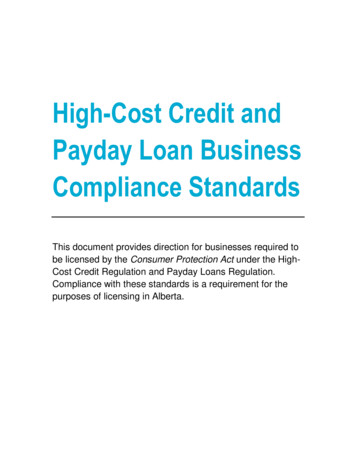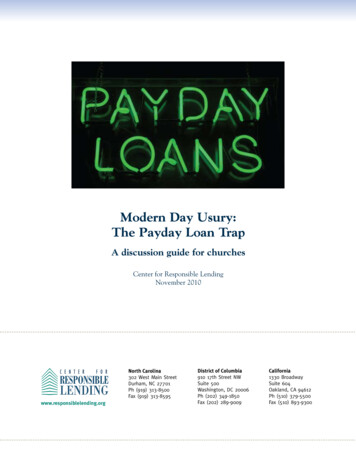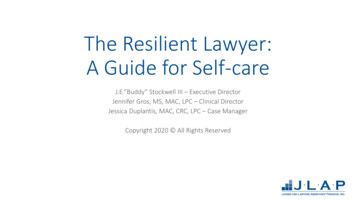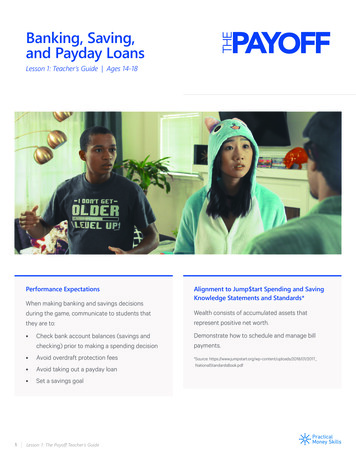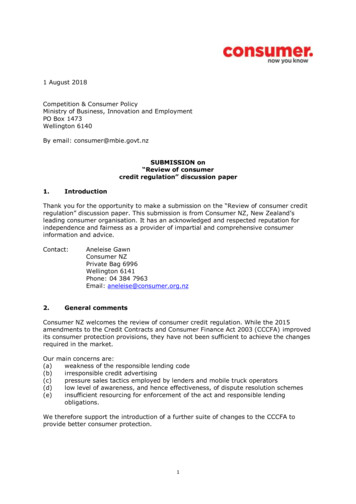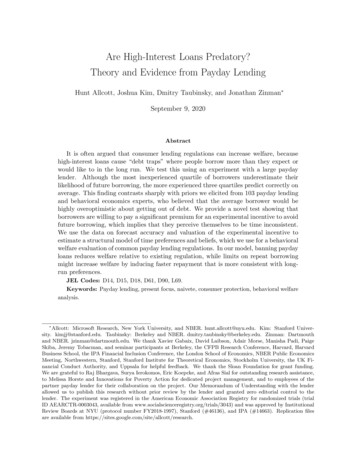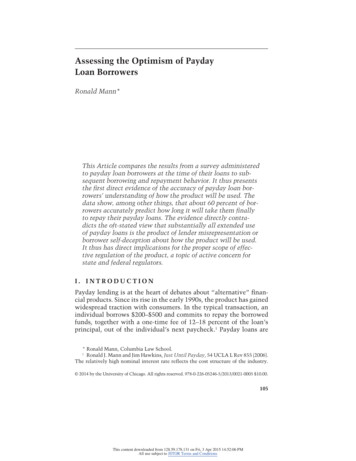
Transcription
Assessing the Optimism of PaydayLoan BorrowersRonald Mann*This Article compares the results from a survey administeredto payday loan borrowers at the time of their loans to subsequent borrowing and repayment behavior. It thus presentsthe first direct evidence of the accuracy of payday loan borrowers’ understanding of how the product will be used. Thedata show, among other things, that about 60 percent of borrowers accurately predict how long it will take them finallyto repay their payday loans. The evidence directly contradicts the oft-stated view that substantially all extended useof payday loans is the product of lender misrepresentation orborrower self-deception about how the product will be used.It thus has direct implications for the proper scope of effective regulation of the product, a topic of active concern forstate and federal regulators.I. INTRODUCTIONPayday lending is at the heart of debates about “alternative” financial products. Since its rise in the early 1990s, the product has gainedwidespread traction with consumers. In the typical transaction, anindividual borrows 200– 500 and commits to repay the borrowedfunds, together with a one-time fee of 12–18 percent of the loan’sprincipal, out of the individual’s next paycheck.1 Payday loans are* Ronald Mann, Columbia Law School.1Ronald J. Mann and Jim Hawkins, Just Until Payday, 54 UCLA L Rev 855 (2006).The relatively high nominal interest rate reflects the cost structure of the industry. 2014 by the University of Chicago. All rights reserved. 978-0-226-05246-5/2013/0021-0005 10.00.105This content downloaded from 128.59.178.131 on Fri, 3 Apr 2015 14:52:06 PMAll use subject to JSTOR Terms and Conditions
106Assessing the Optimism of Payday Loan Borrowersnow available at about 20,000 storefront locations throughout theNation, where more than ten million Americans borrowed money in2010.2 To put their success in context, there are more payday lenderlocations in this country than there are Starbucks and McDonald’slocations combined.3Concerns about payday lending come from its role in the development of “fringe” lending, which has played a major part in the oftchronicled rise of modern America’s culture of indebtedness.4 Witha vehemence surprising for a product so successful with consumers,consumer advocates are almost uniformly critical of the product.5Two attributes in particular attract the most attention. The first isthe relatively high interest rates characteristic of the product, whichtypically are in the range of 400 percent (a fixed fee of about 15 percent for a loan of two weeks or less).6 Concerns about those ratesled, for example, to 2007 legislation prohibiting loans to militaryOn the one hand, operating costs do not decline proportionately with the size of theloan; thus, the administrative costs for small loans are quite high when measured ona percentage basis. At the same time, because the loans are effectively unsecured andtypically made with relatively little inquiry into creditworthiness, losses are not insubstantial. Edward C. Lawrence and Gregory Elliehausen, A Comparative Analysisof Payday Loan Customers, 26 Contemp Econ Pol 299 (2008). For a detailed numerical analysis of the operating expenses and losses of payday lenders and how thosecompare to fee revenues, see Gregory Elliehausen, An Analysis of Consumers’ Useof Payday Loans (George Washington University, Financial Services Research Program Monograph No 41, Jan 2009), available at s 01-2009.pdf.2The Pew Project, Payday Lending in America: Who Borrows, Where They Borrow, and Why (Pew Safe Small-Dollar Loans Research Project Report, July 2012),available at http://www.pewstates.org/uploadedFiles/PCS Assets/2012/Pew PaydayLending Report.pdf.3Donald P. Morgan, Michael R. Strain, and Ihab Seblani, How Payday CreditAccess Affects Overdrafts and Other Outcomes, 44 J Money Credit & Bank 519(2012).4John P. Caskey, Fringe Banking: Check-Cashing Outlets, Pawnshops and thePoor (Sage 1996); Donncha Marron, Consumer Credit in the United States: A Sociological Perspective from the 19th Century to the Present (Palgrave Macmillan 2009);Robert Mayer, Quick Cash: The Story of the Loan Shark (Northern Illinois 2010);David Graeber, Debt: The First 5,000 Years (Melville House 2011); Louis Hyman,Borrow: The American Way of Debt (Random 2012).5Creola Johnson, Congress Protected the Troops: Can the New CFPB Protect Civilians from Payday Lending, 69 Wash & Lee L Rev 649 (2012); Nathalie Martin andJoshua Schwartz, The Alliance Between Payday Lenders and Tribes: Are Both TribalSovereignty and Consumer Protection at Risk, 69 Wash & Lee L Rev 751 (2012);Christopher Peterson, Taming the Sharks (Akron 2004).6Mann and Hawkins, 54 UCLA L Rev at 855 (cited in note 1).This content downloaded from 128.59.178.131 on Fri, 3 Apr 2015 14:52:06 PMAll use subject to JSTOR Terms and Conditions
Ronald Mann107personnel and their families at interest rates above 36 percent;7 thisessentially terminated payday lending to military families.8The second concern relates to persistent use of the product. It iswell known that many borrowers use the product frequently; in thecommon phrasing they are said to “roll over” the loans from payperiod to pay period because they lack the funds to pay them off asthey come due. This leads consumer advocates to fear that borrowers frequently become “mired” in debt that they could have avoidedhad they never used the product.9 The specific concern is that excessive optimism causes users to believe they will pay off their loansrapidly, when in fact they usually will not. Indeed, Bar-Gill and Warren go so far as to assert that no rational consumer expecting to rollover the loan would agree to the terms of a payday loan.10These concerns are at the forefront of current regulatory initiatives at the state and federal level. At the state level, many stateshave adopted specific limitations on rollovers.11 Still others haveadopted even stricter regimes that effectively ban payday lendingat retail locations.12 But the most notable activity has come at thefederal level, with the recent formation of the federal Consumer Financial Protection Bureau (CFPB). Two regulatory innovations aresalient. First, the agency has not only the authority long held bythe Federal Trade Commission to respond to unfair and deceptivepractices, but also a new, broader power over “abusive” practices byfinancial firms.13 In addition to having broader substantive powers,the CFPB also has sweeping regulatory and supervisory jurisdictionThe Talent-Nelson Amendment, Section 670 of the John Warner National Defense Authorization Act for Fiscal Year 2007, Pub L No 109-364, 120 Stat 2083, wascodified at 49 USC § 987.8Johnson, 69 Wash & Lee L Rev at 649 (cited in note 5); Patrick Aul, FederalUsury Law for Service Members: The Talent-Nelson Amendment, 12 NC Bank Inst163 (2008).9Mayer, Quick Cash (cited in note 4); Peterson, Taming the Sharks (cited innote 5); Alan M. White, Behavior and Contract, 27 L & Ineq J 135 (2009).10Oren Bar-Gill and Elizabeth Warren, Making Credit Safer, 157 U Pa L Rev 144–46 (2008). Alan White’s analysis is similar. Alan M. White, Behavior and Contract, 27 L & Ineq J 135, 159–63 (2009).11Mann and Hawkins, 54 UCLA L Rev at 897–98 (cited in note 1).12National Conference of State Legislatures, Payday Lending Statutes (2013),available at nd-commerce/payday-lending-state-statutes.aspx; Pew Project, Payday Lending in America (cited innote 2); Morgan, Strain, and Seblani, 44 J Money Credit & Bank (cited in note 3); SealyHutchings and Matthew J. Nance, Credit Access Businesses: The Regulation of Payday and Title Loans in Texas, 66 Consumer Fin L Q Rep 76 (2012) (discussing recentlegislative initiatives in Texas).1312 USC § 5531.7This content downloaded from 128.59.178.131 on Fri, 3 Apr 2015 14:52:06 PMAll use subject to JSTOR Terms and Conditions
108Assessing the Optimism of Payday Loan Borrowersover bank and nonbank financial service providers that previouslydid not exist at the federal or state level.14 Because federal regulatorspreviously had no direct supervision over the lending practices ofnonbanks like the major payday lenders, the new authority of theCFPB raises the possibility of major new regulatory initiatives inthis area.15Recent CFPB enforcement actions against major credit card issuers16 suggest it will pursue its mandate vigorously, which makesan accurate perspective on the payday loan a valuable commodity.Because the CFPB has no authority to regulate interest rates17 concerns about repetitive use and rollovers are likely to be at the heartof any such regulatory initiative. For example, the director of theagency recently suggested the propriety of CFPB action against products for which “a substantial percentage of users rol[l] over theirdebts on a recurring basis” because those products amount to “debttraps.”18 Moreover, the CFPB’s recently published white paper onpayday loans directly decries the repetitive use of the product andavows an intention to consider mandating cooling-off periods as amatter of federal law.19 Press reports suggest that similar action bythe Comptroller of the Currency and Federal Deposit Insurance Corporation against large banks is also in the works.20In the spirit of the call by Sunstein for empirical validation ofregulatory strategies, this study responds with a direct test of theaccuracy of consumer understanding about repetitive use of theproduct.21 Comparing the results from a survey administered to payday loan borrowers at the time of their loans to subsequent borrowing and repayment behavior, this essay presents the first directevidence of the accuracy of payday loan borrowers’ understanding of14The CFPB was created by Title X of Dodd-Frank, the Dodd-Frank Wall StreetReform and Consumer Protection Act, Pub L No 111-203, 124 Stat 1376, §§ 10011100H. The regulatory authority directed specifically at nonbank financial serviceproviders appears in Section 1024 of Dodd-Frank, codified at 12 USC § 5514.15Johnson, 69 Wash & Lee L Rev at 649 (cited in note 5).16See In re Capital One Bank, (USA) NA, No 2012-CFPB-0001 (July 18, 2012) (consent order); In re American Express Centurion Bank, No FDIC 12315b etc (Sept 21,2012) (consent order); In re Discover Bank Greenwood Delaware, No FDIC-11-548betc (Sept 24, 2012) (consent order).1712 USC § 5517(o).18Richard Cordray, Prepared Remarks by Richard Cordray, Director of the Consumer Financial Protection Bureau (2013).19Id.20Jessica Silver-Greenberg, Major Banks Aid in Payday Loans Banned by States,NY Times (Feb 23, 2013).21Cass R. Sunstein, Empirically Informed Regulation, 78 U Chi L Rev 1349(2011).This content downloaded from 128.59.178.131 on Fri, 3 Apr 2015 14:52:06 PMAll use subject to JSTOR Terms and Conditions
Ronald Mann109the product. In general, the evidence suggests two things. First, mostborrowers do not expect that they will be free of debt at the end ofthe first loan term; on the contrary, more than half of borrowersexpect that they will need to continue to borrow for additional paycycles. Borrower estimates of an ultimate repayment date are realistic; the mean predicted period of borrowing after the initial loanmatures is thirty-six days. Among other things, that finding directlyrebuts the idea that borrowers never understand that they are likelyto roll their loans over.More important for present purposes, most (though surely notall) borrowers have a good understanding of their own use of theproduct. Specifically, most borrowers finally repay their loans andare free of debt within two weeks of the date they predicted on thedate of the loan. The evidence that such a large share of borrowersaccurately understand how the product will be used contradicts theaccepted premise that substantially all extended use of payday loansis the product of lender misrepresentation or borrower self-deceptionabout how the product will be used. More broadly, that evidence renders irrelevant the oft-stated premise of behavioral policy-making,the so-called golden rule of policy-making under which regulatoryintervention is appropriate only if it can correct a choice that is anerror for substantially all of those who make it.22Section II of the Article situates the survey against prior writingabout payday loans. Section III describes the survey and resultingdataset. Section IV describes the results. Section V elucidates the implications of the empirical results for the theoretical and policy debates about payday lending regulation. Section VI briefly concludesand suggests directions for extension.II. LITERATURE REVIEWThe focus of this essay is on the particular concern that payday loanborrowers do not understand the product, and specifically that abias toward optimism causes them systematically to overestimatethe likelihood that they will be able to free themselves from debtpromptly. The idea of an optimism bias is often attributed to thewell-known study by Weinstein of the life expectations of students.23The basic concept is that individuals systematically assess theirown future opportunities and behavior with undue and excessiveRichard H. Thaler and Cass R. Sunstein, Nudge: Improving Decisions aboutHealth, Wealth, and Happiness (Yale 2008).23Neil D. Weinstein, Unrealistic Optimism about Future Life Events, 39 J Personality & Soc Psych, 806 (1980).22This content downloaded from 128.59.178.131 on Fri, 3 Apr 2015 14:52:06 PMAll use subject to JSTOR Terms and Conditions
110Assessing the Optimism of Payday Loan Borrowersoptimism. Buttressed by numerous empirical studies,24 the idea hasbeen widely accepted as a basic tenet of the behavioral economicsliterature.25Among legal academics, concerns about the optimism bias asa cause of excessive use of payday loans have been pervasive. Theclaim has been pressed in passing by several scholars,26 but by farthe most prominent and detailed support for that perspective comesfrom Oren Bar-Gill and Elizabeth Warren. Payday loans are one ofthe central examples in their work “Making Credit Safer.”27 Theirstrategy with respect to payday loans is to suggest that borrowerswho roll their loans over have underestimated the risk of nonpayment, reflecting their premise that no rational consumer would borrow from a payday lender with an expectation to roll over the loan.Thus, they argue, only the “customer who misestimates her abilityto repay the loan in fourteen days will likely roll the loan over.”28That perspective is particularly important because of their role inthe creation and design of the CFPB,29 and because of Warren’s placenow in the United States Senate (on the Senate Banking Committee), where she can be expected to play a key role in financial regulation.A similar perspective pervades the more recent work of the PewCharitable Trusts’ Safe Small-Dollar Loans Research Project. A 2012study based on a nationally representative survey of payday lending24Ernest J. Doleys and Guy A. Renzaglia, Accuracy of Student Prediction of College Grades, 41 Personnel & Guidance J 528 (1963); Lynn A. Baker and Robert E.Emery, When Every Relationship Is Above Average: Perceptions and Expectationsof Divorce at the Time of Marriage, 17 L & Human Beh 439 (1993); Phanikiran Radhakrishnan, Holly Arrow, and Janet A. Sniezek, Hoping, Performing, Learning, andPredicting: Changes in the Accuracy of Self-Evaluations of Performance, 9 Hum Performance 23 (1996); Terence R. Mitchell, et al, Temporal Adjustments in the Evaluation of Events: The “Rosy View,” 33 J Exper Soc Psych, 421 (1997); D.A. Amor andS.E. Taylor, When Predictions Fail: The Dilemma of Unrealistic Optimism, in T.Gilovich, D. Griffin, and D. Kahneman, eds, Heuristics and Biases: The Psychologyof Intuitive Judgment (Cambridge 2002).25Christine Jolls, Behavioral Economics Analysis of Redistributive Legal Rules,51 Vand L Rev, 1653 (1998); Cass R. Sunstein, Hazardous Heuristics, 70 U Chi L Rev751 (2003); Thaler and Sunstein, Nudge (cited in note 22); Tali Sharot, The OptimismBias: A Tour of the Irrationally Positive Brain (Pantheon 2011).26Peterson, Taming the Sharks (cited in note 5); White, 27 L & Ineq J at 135 (citedin note 10).27Bar-Gill and Warren, 157 U Pa L Rev at 1 (cited in note 10).28Id at 44.29For their recommendations of something like CFPB, see Elizabeth Warren, Unsafe at Any Rate, 5, Democracy, 8 (2007) online at http:www.democracyjournal.org/5/6528.php?page all; Elizabeth Warren, Redesigning Regulation: A Case Study fromthe Consumer Credit to Market (2012).This content downloaded from 128.59.178.131 on Fri, 3 Apr 2015 14:52:06 PMAll use subject to JSTOR Terms and Conditions
Ronald Mann111borrowers finds that most borrowers do not use the product for shortperiods of time, but rather are indebted for about five months out ofeach year.30 Again, that study works from the premise that the product is designed for immediate repayment, and that use in extendedborrowing cycles necessarily is problematic. In their own words, theproduct’s actual use is in “sharp contrast” to its “advertise[ment]as short-term, small-dollar credit intended for emergency or specialuse.”31 Those concerns are even more prominent in the most recentreport from the Pew Project, which emphasizes the premise thatborrowers “hold unrealistic expectations about payday loans.”32Although the perspective articulated by Bar-Gill, Warren, and Pewhas been taken for granted among legal scholars, its analytical shortcomings are apparent. For one thing, as a theoretical matter, it is notat all clear that optimistic behavior reflects poor financial choices.Thus, such empirical evidence as there is suggests that those whoare optimistic in fact often (though certainly not always) make better financial choices than those who are not.33 Moreover, it is wellknown that many consumers do a poor job of managing their lifetime consumption and savings choices. The typical “prudent” consumer invests too conservatively, resulting in a substantial shortfallin lifecycle investing; Ayres and Nalebuff vigorously argue that amore “audacious” pattern of behavior would be beneficial.3430Pew Project, Payday Lending in America (cited in note 2). Having said that,the overdraft rates reported by the Pew Project, Payday Lending in America: Report 2: How Borrowers Choose and Repay Payday Loans (hereinafter Report 2) 19,33 (Pew Safe Small-Dollar Loans Research Project Report, 2013), suggest that the Pewsample involves a considerably less creditworthy group of borrowers than the sampleanalyzed here. This most likely relates to the inclusion in the Pew sample of a largenumber of online customers (451 storefront customers and 252 internet customers).Pew Project, Report 2 at 55 (cited in note 30). Because those lenders are not readilysupervised by state regulators, there is a strong likelihood of more abusive lendingand collection practices, and considerable reason to think that the borrowing pool isless creditworthy. Silver-Greenberg, NY Times (Feb 23, 2013) (cited in note 20); PewProject, Report 2 at 16. The Pew data also warrant caution because they are based onpost hoc estimates by borrowers of prior borrowing behavior, rather than direct observation of behavior documented in loan records (the strategy for this project).31Pew Project, Payday Lending in America at 13 (cited in note 2). The suggestionthat the lenders are misrepresenting the nature of the product in some way is notunique to the Pew Project. See, for example, White, 27 L & Ineq J at 159 (cited innote 10) (suggesting that payday loans “are described (falsely) as a short-term creditproduct, exploiting the consumer’s optimism bias”).32The Pew Project, Report 2 at 19 (cited in note 30).33Manju Puri and David T. Robinson, Optimism and Economic Choice, 68 J FinEcon 71 (2007).34Id; Ian Ayres and Barry Nalebuff, Lifecycle Investing: A New, Safe, and Audacious Way to Improve the Performance of Your Retirement Portfolio (Basic 2010).This content downloaded from 128.59.178.131 on Fri, 3 Apr 2015 14:52:06 PMAll use subject to JSTOR Terms and Conditions
112Assessing the Optimism of Payday Loan BorrowersAlso, as an empirical matter, it seems far too simple to attributemisperception of product use to a vague and general bias toward“optimism.” More recent scholars have emphasized the variety ofcognitive limitations that might lead to arguably ill-advised borrowing. For example, some borrowing might relate to a misprediction offuture self-control (such as a failure to appreciate the likely effectsof hyperbolic discounting), a classic example of the optimism bias.35Others recently have emphasized the possibility that scarcity creates a cognitive “load” that might force inattention to the costs offuture borrowing.36 Still again, some of the borrowing is likely torelate to a misprediction of the income and consumption shocksnecessary for repayment to occur.37 Thus, absent a research designthat can distinguish among those causes, even empirical evidencethat borrowers mispredict their use of the product well might reflectany number of problems more or less closely related to excessiveoptimism.Against that background, it is distressing that those who seemso sure that all payday loan borrowers are making incorrect choiceshave failed to observe either the theoretical or empirical ambiguitythat plagues their claims. Indeed, legal scholars writing about therole of optimism bias in consumer lending have not for the mostpart offered empirical evidence;38 rather they have imported thefindings of the behavioral economists and psychologists into thiscontext, using the possibility of optimism bias to explain increasesin consumer borrowing.39 Hence, empirical work about the prevalence and significance of optimism among payday loan borrowershas come from other venues.35Paige Skiba and Jeremy Tobacman, Payday Loans, Uncertainty and Discounting: Explaining Patterns of Borrowing, Repayment, and Default (Vanderbilt Law andEconomics Research Paper No 08-33, Aug 21, 2008), online at http://papers.ssrn.com/sol3/papers.cfm?abstract id 1319751 (visited July 12, 2013).36Anuj K. Shah, Sendhil Mullainathan, and Eldar Shafir, Some Consequences ofHaving Too Little, 338 Science 682 (2012).37Ronald J. Mann, After the Great Recession: Regulating Financial Services forLow- and Middle-Income Communities, 69 Wash & Lee L Rev 729 (2012).38This is of course a commonly noted problem with much of the legal scholarshipapplying behavioral analysis. Doron Teichman, The Optimism Bias of the Behavioral Analysis of Crime Control, 2011 U Ill L Rev 1697, 1710.39Richard M. Hynes, Overoptimism and Overborrowing, 2004 BYU L Rev 127(2004); Cass R. Sunstein, Boundedly Rational Borrowing, 73 U Chi L Rev 249 (2006);Nathalie Martin and Ocean Tama y Sweet, Mind Games: Rethinking BAPCPA’sDebtor Education Provisions, 31 SIU L J 517 (2006); Adam J. Levitin, Finding Nemo:Rediscovering the Virtues of Negotiability in the Wake of Enron, 2007 Colum Bus LRev 83 (2007).This content downloaded from 128.59.178.131 on Fri, 3 Apr 2015 14:52:06 PMAll use subject to JSTOR Terms and Conditions
Ronald Mann113An important paper by Bertrand and Morse tests the effectivenessof various disclosure forms in altering perceptions about how theproduct will work.40 Bertrand and Morse also surveyed borrowersabout how long they believed payday loans typically remain outstanding; about half the borrowers in their study thought that loanstypically remain outstanding beyond the base two-week period. Arecent survey by researchers at the Center for Financial ServicesInnovation asked a sample of borrowers using a variety of alternativefinancial services, after the fact, if it “took more time than expectedto repay the loan.” Of the payday loan borrowers, only 32 percentreported that it did take longer than expected.41 Similarly, the 2013report from the Pew Project addresses this question obliquely, finding on the one hand that the overwhelming majority of borrowersreport the terms of the transactions as clear but at the same timereport that they do not have funds in their monthly budget to repaythe loan in one cycle.42Collectively, those studies suggest that payday lending borrowersunderstand that many borrowers roll over their loans, and that thisunderstanding is, at the most general level, accurate. Neither study,however, sheds any light on the central factual question: how welldo individual borrowers understand their own likely future behavior? If optimism in fact is driving these decisions, then borrowerssystematically are likely to underestimate the time to repayment.That is the question that motivated this study.III. DATA AND METHODSA. The Survey1. Survey Design. Because the survey instrument was to be administered to borrowers at the point of borrowing, the interest in obtaining a high response rate suggested that it should be concise, limitedto one side of a single sheet of paper. Limited by that constraint, theinstrument inquires about borrower characteristics, use of the borrowed funds, and borrower expectations about repayment.Marianne Bertrand and Adair Morse, Information Disclosure, Cognitive Biases,and Payday Borrowing, 66 J Fin 1865 (2011).41Rob Levy and Joshua Sledge, A Complex Portrait: An Examination of SmallDollar Credit Consumers (Center for Financial Services Innovation, Aug 2012), availableat A%20Complex%20Portrait.pdf.42Pew Project, Report 2 at 13–17.I (cited in note 30).40This content downloaded from 128.59.178.131 on Fri, 3 Apr 2015 14:52:06 PMAll use subject to JSTOR Terms and Conditions
114Assessing the Optimism of Payday Loan BorrowersThe questions eliciting background data mirror similar questionsexamined in the existing literature,43 and help to establish a baselineof the characteristics of the payday loan borrowers in the sample.The instrument collects information about race, age, gender, education, and prior experience with payday lenders.On the second topic, the instrument offers thirteen specific uses.Borrowers can check as many as apply or add text into a catchall intowhich borrowers can add written comments; that question tracksprecisely the question asked on that topic in Bertrand and Morse44with the addition of an option for education expenses.The focal point of the survey is assessing the quality of borrowerunderstanding of how the product will be used. Initially, the objectwas to take the topic of Bertrand and Morse45 and test the accuracyof perception, by comparing the borrower’s expectation to actualsubsequent borrowing and repayment behavior. As it turned out,however, it was far more complicated than expected to modify theBertrand and Morse survey question for this project.The Bertrand and Morse survey included the following question:“What’s your best guess of how long it takes the average person topay back in full a 300 payday loan? Please answer in weeks.”46 Inmodifying that question for use in this survey, several issues arose,which ultimately led to three separate questions on this topic. Thebiggest problem relates to the inherent ambiguity of what it meansin this context to pay a loan “back in full.” As it happens, the lawof many states (including the five states in which the survey wasgiven) technically forbids “rollover” loans.47 Still, it is possible inmost states (including all of the survey states other than Florida) forthe lender to conduct same-day transactions in which a new loan isissued on the same day as the loan being paid off. Although the difference between a rollover (collecting a new fee and extending theterm of the existing loan) and issuing a new loan shortly after repayment of the old loan might seem technical, it complicates the survey process considerably. For one thing, excluding borrowers whodefault on the first loan (and there were no such borrowers in thisdataset), all borrowers in fact pay the loan back in full at the conclu43Lawrence and Elliehausen, 26 Contemp Econ Pol at 299 (cited in note 1); Elliehausen, Consumers’ Use of Payday Loans (cited in note 1); Michael S. Barr, NoSlack: The Financial Lives of Low-Income Americans (Brookings 2012).44Bertrand and Morse, 66 J Fin at 1870 (cited in note 40).45Id at 1876.46Id.47Cal Fin Code § 23037(a); Fla Stat § 560.404(19) (requiring twenty-four-hourcooling-off period between loans); Kan Stat Ann § 16a-2-404(6); La Rev Stat § 9:3578.6(7) (permitting rollovers only upon partial prepayment); 59 Okla Stat § 3109(A).This content downloaded from 128.59.178.131 on Fri, 3 Apr 2015 14:52:06 PMAll use subject to JSTOR Terms and Conditions
Ronald Mann115sion of the first pay period.48 Thus, if I had used the Bertrand andMorse question without revision (asking how many weeks it wouldtake for a loan to be paid “back in full”), all borrowers who understood the product and answered truthfully would have respondedwith an answer indicating the original date of maturity (in this dataset typically something less than fourteen days). Yet if the questionis designed to test perceptions about rollovers, such answers wouldindicate ignorance of the likelihood that many if not most of theborrowers would take out a new loan shortly after repayment of theoriginal loan.49 Because of the difficulty of separating the responsesthat might reflect a literal reading of the question from those thatmight reflect a colloquial reading of the question, I decided to phrasethe question differently.Trying to ask a question that could be answered with literal accuracy in an informative way, I revised the Bertrand and Morse question and divided it into two separate questions. The first asks aboutthe borrower’s anticipation of whether the survey loan will be rolledover: “Do you expect to continue this borrowing after the due dateof this loan?” Paired with that question is a follow-up about theextent of likely rollovers, roughly parallel to the Bertrand and Morseestimate: “If so, for how
20 Jessica Silver-Greenberg, Major Banks Aid in Payday Loans Banned by States, NY Times (Feb 23, 2013). 21 Cass R. Sunstein, Empirically Informed Regulation, 78 U Chi L Rev 1349 (2011). This content downloaded from 128.59.178.131 on Fri, 3 Apr 2015 14:52:06 PM All use subject to JSTOR Terms and Conditions.


